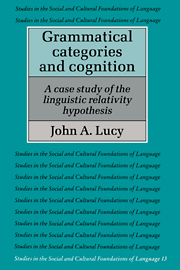Book contents
- Frontmatter
- Contents
- List of figures
- List of tables
- Acknowledgments
- Introduction
- 1 Background of the comparative research in Yucatan, Mexico
- 2 Comparison of grammatical categories: nominal number in English and Yucatec
- 3 Cognitive assessment
- 4 Conclusions
- Appendices
- A Construction of picture stimuli
- B Administration of task series
- C Scoring conventions and summary data for verbal tasks
- Notes
- References
- Index
B - Administration of task series
Published online by Cambridge University Press: 19 January 2010
- Frontmatter
- Contents
- List of figures
- List of tables
- Acknowledgments
- Introduction
- 1 Background of the comparative research in Yucatan, Mexico
- 2 Comparison of grammatical categories: nominal number in English and Yucatec
- 3 Cognitive assessment
- 4 Conclusions
- Appendices
- A Construction of picture stimuli
- B Administration of task series
- C Scoring conventions and summary data for verbal tasks
- Notes
- References
- Index
Summary
Subject characteristics and task sequence
A general description of subjects engaging in the tasks and the sequence of tasks was given in chapters 1 and 3. Tables 39 and 40 present additional specific details on these topics. Only tasks 6–12 in these tables have been reported here. The series 1 experiments concerned other issues and only served in the present context to familiarize the men with the task procedures. Unnumbered items represent supplementary procedures used with the preceding numbered task.
Counterbalancing of stimulus presentation
The picture stimuli were not easy to construct. Thus, it was desirable to use each picture in more than one task and to have every subject deal with each picture at some point, but not necessarily always in the same tasks.
Given five tasks (I–V), three sets of pictures (labeled 1, 2, and 3), and the requirement that a common picture set be used in Tasks I and V, and in Tasks II and III, six possible presentation orders (i–vi) are possible as indicated in table 41. On the basis of this, it made sense for subjects to be sought in groups of six since all possible orders could be equally represented.
Finally, since each picture set contained three originals (for example, 1.1, 1.2, 1.3), it was possible to order the presentation within each set in six possible ways as well. As there were not enough subjects to completely counterbalance this factor, the six possible combinations were assigned randomly (without replacement) to the six occurrences of each set associated with each six subjects.
- Type
- Chapter
- Information
- Grammatical Categories and CognitionA Case Study of the Linguistic Relativity Hypothesis, pp. 179 - 184Publisher: Cambridge University PressPrint publication year: 1992



